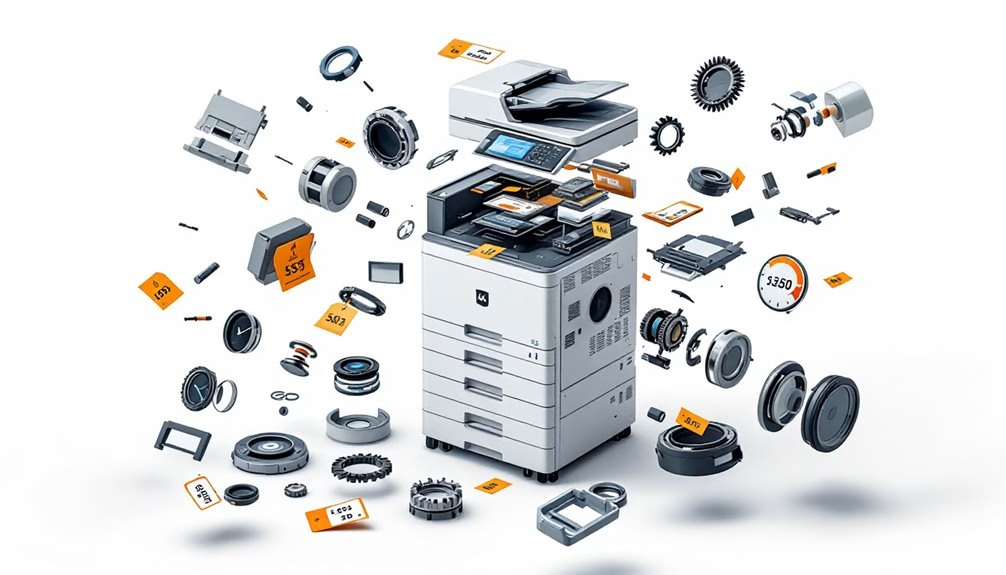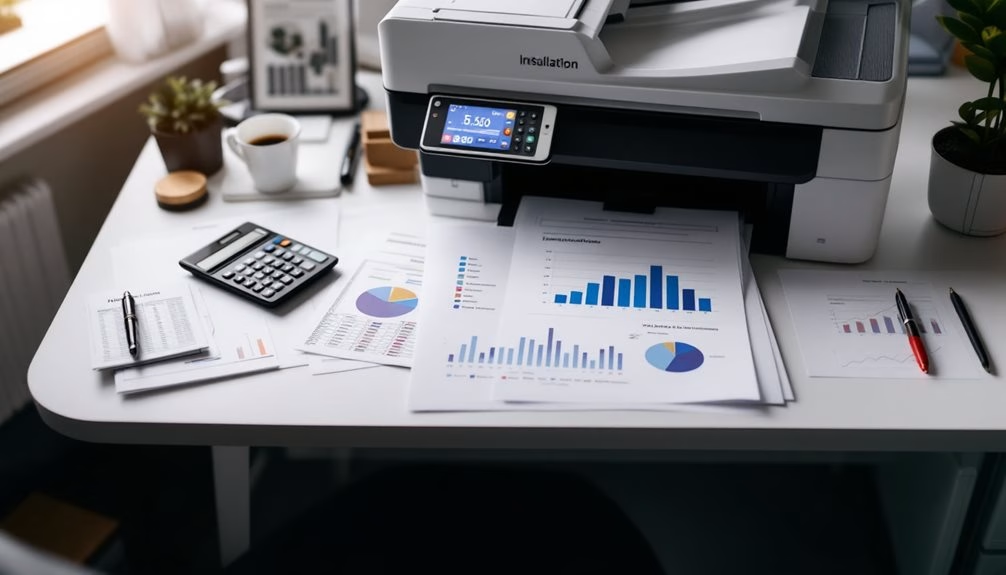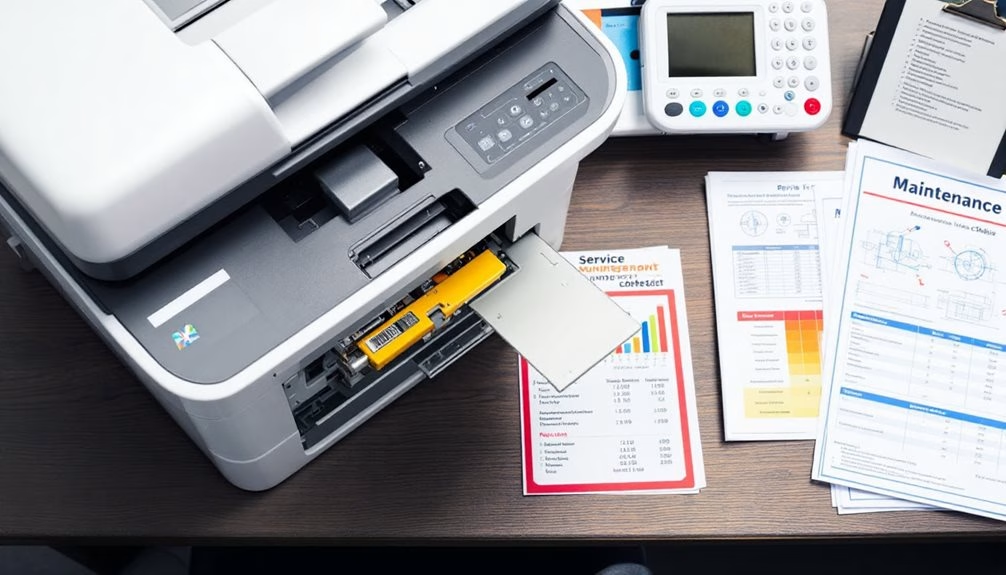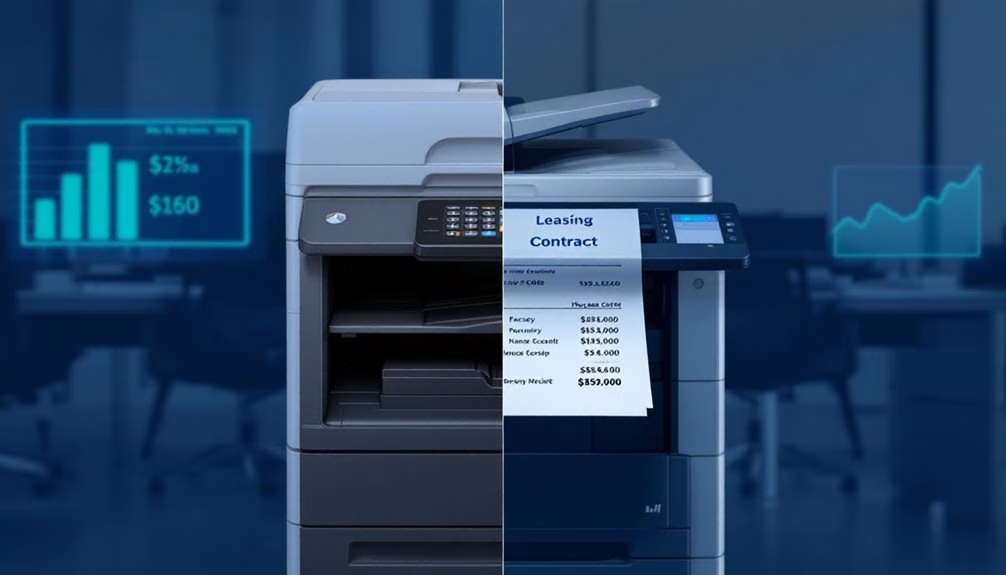When we talk about acquiring copiers for our business, we’re often swayed by attractive purchase prices or monthly lease rates. But these figures only tell part of the story. The true financial impact comes from the Total Cost of Ownership (TCO), which encompasses everything from initial acquisition to the last page printed. We’ve seen too many companies make costly mistakes by overlooking critical TCO factors that eventually drain their budgets. So what exactly should we be calculating?
Expert Highlights
- Add up all costs including purchase price, consumables, maintenance, energy usage, and employee downtime.
- Compare leasing versus purchasing to determine the most cost-effective option for your business needs.
- Factor in implementation expenses like installation, training, and network integration which add 15-20% to initial investment.
- Evaluate service agreements closely for response times, parts coverage, and preventative maintenance provisions.
- Consider Managed Print Services to potentially reduce total operating costs by up to 30%.
Understanding the Components of Copier TCO

When businesses evaluate copiers, they often focus solely on the purchase price, overlooking the true financial commitment that extends far beyond the initial investment.
We need to evaluate multiple factors that contribute to the total cost of ownership. These include consumables (toner, paper, drums), maintenance contracts, energy consumption, and repair costs.
Let’s not forget the hidden expenses of downtime, employee training, and eventual disposal costs.
Implementing Managed Print Services can reduce these total printing expenses by up to 30% through improved device usage and more efficient supply management.
Calculating Acquisition and Implementation Costs

Now that we’ve examined the extensive nature of TCO, let’s focus on the initial financial outlay.
Understanding TCO is crucial, but the initial financial commitment deserves special attention before proceeding.
Acquisition costs include the purchase price or lease terms, but don’t forget implementation expenses that often catch businesses off-guard.
When calculating these costs, we need to take into account:
- Purchase price or lease down payment
- Installation fees
- Initial training sessions
- Network integration
- Software licensing
- Delivery charges
- Removal of old equipment
Many of our colleagues overlook these secondary expenses, which can add 15-20% to the initial investment.
Consider exploring our flexible leasing options that are specifically designed to accommodate your budget while minimizing upfront implementation costs.
Projecting Ongoing Operational Expenses

Operational expenses represent the hidden iceberg beneath the surface of copier ownership.
We’re often lulled into focusing on purchase price alone, but ongoing costs typically dwarf initial investments over time.
Let’s track these expenses systematically.
Toner, paper, and other consumables form your baseline costs.
Add maintenance contracts, repair services, and technician visits for a complete picture.
Don’t forget electricity consumption—modern machines vary dramatically in energy efficiency.
Staff time counts too.
Frequent paper jams or complicated interfaces waste valuable employee hours.
Together, we’ll analyze these factors to project realistic five-year operational costs, ensuring we make copier decisions that serve our community’s long-term needs.
Options like leasing provide flexible financing options that can help businesses better manage their total cost of ownership while maintaining access to premium equipment.
Analyzing Maintenance and Service Agreement Options

Although many organizations focus primarily on purchase price and consumables, maintenance and service agreements often represent the most negotiable aspect of your total cost of ownership.
When evaluating service agreements, we recommend comparing response times, parts coverage, and technician qualifications.
Look for agreements that include preventative maintenance visits, which can reduce downtime and extend equipment life.
Don’t overlook contract flexibility. We’ve found the best agreements allow you to adjust coverage levels as your needs change.
Ask about escalation clauses that might increase costs annually.
Consider requesting quotes from local suppliers for more competitive pricing on service agreements and maintenance options.
Comparing Lease vs. Purchase Financial Implications

Beyond service agreements, organizations face a fundamental financial decision: lease or purchase?
When we lease copiers, we avoid large upfront costs and gain predictable monthly expenses.
We’re also free from obsolescence concerns as we can upgrade at lease-end. However, we’ll pay more long-term than purchasing outright.
Leasing eliminates technological obsolescence risks, though at a premium compared to ownership over time.
Buying gives us asset ownership and eliminates recurring payments after the initial investment.
We’ll save considerably if we maintain the equipment beyond five years. But we’ll need capital budget availability and must consider eventual replacement costs.
The right choice depends on our cash flow situation, tax implications, and how long we’ll keep the equipment.
Many businesses opt for Operating Lease options to maintain financial flexibility while ensuring regular technology updates.
Frequently Asked Questions
How Does Brand Reputation Impact Long-Term Copier Reliability?
Brand reputation directly correlates with long-term reliability. We’ve found established brands typically offer more dependable copiers, better warranty coverage, and stronger service networks that greatly reduce unexpected failures over time.
What Environmental Certifications Should I Look for in a Copier?
We recommend looking for ENERGY STAR, EPEAT, Blue Angel, and Nordic Swan certifications. They’ll guarantee your copier meets sustainability standards, reduces energy consumption, and uses fewer toxic materials in manufacturing.
How Often Do Copier Models Become Obsolete?
We find copier models typically become obsolete every 3-5 years, though professional-grade machines can remain viable longer. Let’s anticipate this cycle when planning our office technology investments.
Can Copiers Present Cybersecurity Risks to My Network?
Yes, modern copiers can pose significant cybersecurity risks to our network. They’re fundamentally computers with storage, internet connections, and access to sensitive documents—all potential entry points hackers could exploit without proper protection.
How Do Different Copier Brands Compare for Resale Value?
We’ve found that Canon and Xerox typically hold better resale value compared to other brands. However, you’ll want to contemplate warranty benefits and service contracts when making your decision.
Expert Final Thoughts
We’ve seen that evaluating copier TCO requires looking beyond the sticker price. By thoroughly analyzing acquisition costs, operational expenses, maintenance agreements, and lease versus purchase options, we’ll make smarter investments that align with our long-term business goals. Remember, the lowest initial price rarely equals the lowest overall cost. Let’s approach copier procurement with this all-encompassing perspective to avoid budget surprises.
About the Expert
Rafael M.
CEO of JR Copier
With over 35 years of hands-on experience in the copier and office printer industry, Rafael brings unparalleled expertise to every client interaction. His journey from service technician to CEO provides him with comprehensive understanding of all aspects of the business.
Areas of Expertise: Copier and printer sales, equipment leasing strategies, maintenance solutions, and managed print services. Rafael's deep industry knowledge ensures clients receive expert guidance, transparent pricing, and exceptional service for all their office equipment needs.
Connect on LinkedIn